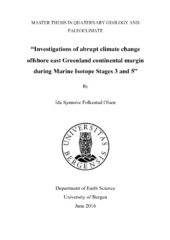Investigations of abrupt climate change offshore east Greenland continental margin during marine isotope stages 3 and 5
Master thesis
Permanent lenke
https://hdl.handle.net/1956/12639Utgivelsesdato
2016-06-01Metadata
Vis full innførselSamlinger
- Department of Earth Science [1050]
Sammendrag
Paleoclimatic records obtained from western Nordic Seas core GS15-198-38CC (70°N, 17°W) exhibit fluctuating climatic patterns of millennial time scales. Here, foraminifera isotope records used to reconstruct sea surface water mass properties indicated that variability changes during the last glacial period (~130 kyr) have been dominated by forcing at precession (21 kyr) and millennial timescales. Observed shifts in δ^18O records, abundance ice-rafted detritus and planktonic foraminifers display a good agreement to Greenland atmospheric temperatures changes, indicating a coupling between ice sheet dynamics and sea surface processes east of the Greenland continental margin. The most frequent abrupt stadial/interstadial changes retained from the marine sediments are known as Dansgaard-Oeschger (D-O) cycles, and appear every 1-2 kyr. These cycles are characterized by abrupt short-lived increase in temperatures (10 ± 5°C) followed by gradual cooling preceding the next rapid event. A second millennial scale feature detected in the sediments record is cooling events culminating significant iceberg discharges analogous to Heinrich events. Mechanisms triggering abrupt changes display uncertainties, but leading hypothesis is attributed to modifications in the Atlantic Meridional Overturning Circulation (AMOC) and deep-water formation initiated by freshwater input. Finally, contrasting climatic variabilities between Marine Isotope Stages 5 and 3 is apparent. MIS 3 is dominated by rapidly fluctuating parameters, indicating climatic changes arising at a high pace. In contrary, MIS 5 exhibit longer, less frequent oscillations suggesting more stable climatic cycles, and hence also a difference in forcing mechanisms.
